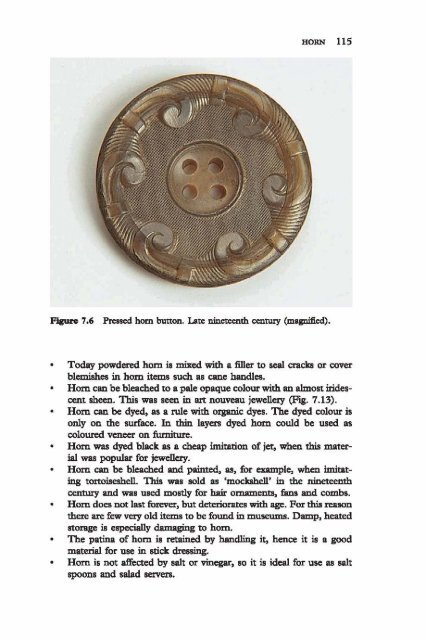- Page 1:
Gem and OrnamentalMaterials of Orga
- Page 6 and 7:
Contents
- Page 8:
Introduction
- Page 13 and 14:
Photo credits
- Page 18 and 19:
AMBER AND COPAL 3Figure 1.1-Insect
- Page 20 and 21:
AMBER AND COPAL 5F M1.5 Poorly pres
- Page 22:
AMBHR AND COPAL 7Figure 1.7 Piece o
- Page 25 and 26:
10 GEMS AND ORNAMIWTAL MATBEUAZS OF
- Page 27 and 28:
12 GEMS AND ORNAMENTAL MA- OF ORGAN
- Page 29:
14 GaMs AND ORNAMENTAL ~~ OF ORGANI
- Page 35 and 36:
20 GHMS AND ORNAMlNTAL MATBRIAIS OF
- Page 37 and 38:
22 GEMS AND ORNAMHNTAL MATERMIS OF
- Page 39 and 40:
24 GEMS AND ORNAMENTAL MATERIMS OF
- Page 44:
AMBER AND COPAL 29Figure 1.34 Piece
- Page 50 and 51:
AMBER AND COPAL 35- - -Figure 1,37
- Page 52:
Figure 1.39 Amber and ivmy casket,
- Page 55 and 56:
40 GEMS AND ORNAMHNTAL MATERMIS OF
- Page 57:
42 GEMS AND ORNAMENTAL MATBElIALS O
- Page 60 and 61:
F I 2.6 Jet simuht showing uneven c
- Page 62:
Figure 2.9Vulcanite chain linlc whi
- Page 66 and 67:
Figure 2,12tesLJet simulant bead, a
- Page 69:
54 GaMs AND ORNAMENTAL ~~ OF ORGANI
- Page 73 and 74:
58 GaMs AND ORNAMENTAL MIXRIMS OF O
- Page 77:
The fedes dso any tu& though theirs
- Page 80: mything hm fish and birds to the la
- Page 85 and 86: 70 GEMS AND ORNAMHNTAL MATERIALS OF
- Page 88: Figure 3.9'Ivorine' plah he&, imimt
- Page 91 and 92: +Even,76 GEMS AND ORNAMWTAL MA- OF
- Page 95 and 96: 80 GBMs AND ORN-AL MATERMIS OF ORGA
- Page 100: 4 Bone
- Page 103 and 104: 88 GEMS AND ORNAMWTAL MA- OF ORGANI
- Page 108 and 109: 5 Antler
- Page 113 and 114: Figure 5*3 Tupilakof reindeer antle
- Page 117 and 118: 6 Rhino horn
- Page 119: 104 GaMs AND ORNAMHNTAL MATERMIS OF
- Page 123 and 124: 7 Horn
- Page 126 and 127: HORN 111
- Page 128: Figme 7.4Various modem horn items.F
- Page 133: 118 GBMs AND ORNAMWTAL MATBEUAZS OF
- Page 136: u d as a scoop or a vessel, and lar
- Page 140 and 141: 8 Tortoiseshell
- Page 142: Fignm 8.3 Overlapping lcutes on the
- Page 145 and 146: Figure 8.6 Brush back with silver p
- Page 147 and 148: F I 8.10 Box combining tortoismhell
- Page 149 and 150: 134 G m AND ORNAMHNTAL MATERIAIS OF
- Page 156 and 157: Tortoisdell ma& Mabuiug Iahd, Toms
- Page 158: The shells are made up of a slightl
- Page 161: 146 G m AND ORNAMHNTAL MATERIAIS OF
- Page 164 and 165: Figure 9.6Baroque pew1 in jewel-.Fi
- Page 166 and 167: 'Shell'). The pearls are iridescent
- Page 169 and 170: 154 GEMS AND OKNAMENTAL ~~ OF ORGAN
- Page 171 and 172: 1Figure 9.13 Nucleated cultured pea
- Page 173: 158 GaMs AND ORN-AL MATBRIAIS OF OR
- Page 176: Figure 9.19 Dyed nucleated cultured
- Page 182:
Figure 9.23 Seed p d necklace. Engl
- Page 186 and 187:
Figure 10.1Con& shell, one end remo
- Page 188:
Figure 10.3 Abalone M e : natural,
- Page 191:
176 GEMS AND ORNAMENTAL MATBRIALS O
- Page 194 and 195:
- (-1.Figure 10.11Conchhyers, olre
- Page 196 and 197:
Figure 10.15bubbles.Detd of abalone
- Page 198 and 199:
have, inevitably, been faked. Mothe
- Page 201 and 202:
186 GBMs AND ORNAMENTAL MTBRIALS OF
- Page 205:
190 GEMS AND ORNAMENTAL MATERIALS O
- Page 210 and 211:
CORAL 195md chalky. Its numl colour
- Page 212 and 213:
CORAL 197-F i11.3 C. firbrarwr roug
- Page 214 and 215:
lgure 11.6dv.Detail of mlwr enhance
- Page 216 and 217:
Figure 11.9 Detail of red soft cora
- Page 218 and 219:
CORAL 203Figure 11,12Brown bamboo c
- Page 220 and 221:
CORAL 205-F I 11.15 Surface, of bhc
- Page 222:
CORAL 207Figum 11.19 Slice of golde
- Page 226 and 227:
CORAL 211YFigure 11.22 Celluloid br
- Page 232:
Figure 11.25 Xaron's bloat'. Comkm
- Page 235:
220 GHFvlS AND ORNAMENTAL MATBElIAL
- Page 239:
224 GEMS AND ORNAMENTAL MATERIALS O
- Page 244 and 245:
MISCEUANEOUS ORGANICS 229Figure 12.
- Page 246:
MIScaLzANaOUS ORGANICS 231Figure 12
- Page 249 and 250:
234 GEM AND ORNAMENTAL MATERIMS OF
- Page 252:
13 Plastics
- Page 257:
242 GHhZs AND ORNAMENTAL MAlXRlMS O
- Page 260 and 261:
Figure 13.5 Bakelire ear-r&, imifat
- Page 264:
14 Quick reference charts
- Page 274:
Bibliography
- Page 278:
Index



